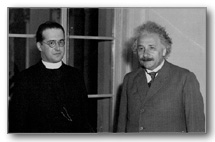Big Bang Theory
The Big Bang Theory is the dominant scientific theory about the origin of the universe. According to the big bang, the universe was created sometime between 10 billion and 20 billion years ago from a cosmic explosion that hurled matter in all directions.
In 1927, the Belgian mathematician and Catholic priest Georges Lemaitre was the first to propose that the universe began with the explosion of a primeval atom. His proposal came after observing the red shift in distant nebulas by astronomers to a model of the universe based on relativity. Years later, Edwin Hubble found experimental evidence to help justify Lemaitre’s theory. He found that distant galaxies in every direction are going away from us with speeds proportional to their distance.
In January 1933, Lemaitre traveled with Albert Einstein to California for a series of seminars. After the Belgian detailed his Big Bang theory, Einstein stood up, applauded, and said, “This is the most beautiful and satisfactory explanation of creation to which I have ever listened.” Lemaitre’s theory, the idea that there was a burst of fireworks which marked the beginning of time and space on “a day without yesterday”, was a radical departure from prevailing scientific understandings, though it has since come to be the most probable explanation for the origin of the universe.

The big bang was initially suggested because it explains why distant galaxies are traveling away from us at great speeds. The theory also predicts the existence of cosmic background radiation (the glow left over from the explosion itself). The Big Bang Theory received its strongest confirmation when this radiation was discovered in 1964 by Arno Penzias and Robert Wilson, who later won the Nobel Prize for this discovery.
Although the Big Bang Theory is widely accepted, it probably will never be proved; consequentially, leaving a number of tough, unanswered questions.
Pre- Genetologic Research, 2000 (400cm x 400cm x 400cm)

Maarten Vanden Eynde
This work was made without any glue, welding, binding or screwing. All pieces are forces in a small square core. The tension is holding everything together. It creates an implosion as well as an explosion. But by having equal forces, the whole thing freezes and comes to a stand. It is representing the end as much as the beginning.